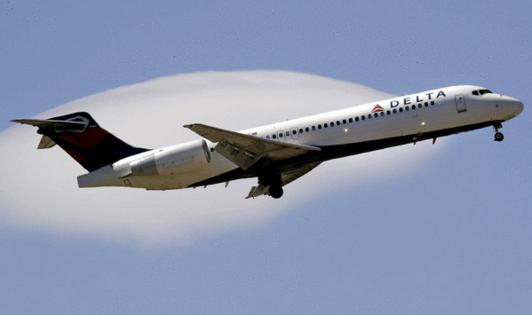Strong airplane turbulence more likely with summer heat, climate change
Published in Science & Technology News
MINNEAPOLIS — For most airline passengers, rumbles and shakes at 37,000 feet might jolt nerves or spill a drink.
But a Delta Air Lines flight that made an emergency landing at Minneapolis-St. Paul International Airport late Wednesday offers a lesson in the real dangers of severe turbulence. While U.S. airlines boast a consistent safety record, rough air is the leading cause of injury on commercial passenger flights.
Serious injuries remain rare, and fatalities rarer still, but aviation experts say that is thanks to the detailed safety systems in place, allowing airlines to chart flight paths that avoid storms and keep pilots aware of hazards along their routes.
But airspace is getting more crowded. And as a shifting climate brings hotter and more extreme weather, particularly during the summer, safe navigation of the skies becomes more challenging.
“The weather environment now is more dynamic. It is more unforeseeable and we are having more severe weather events,” said Mike Slack, a Texas pilot and aviation attorney. “All this translates to more risks for fliers.”
Greg Feith, a pilot and former National Transportation Safety Board investigator, said climate change is leading to warmer temperatures that create more updrafts and higher humidity. In the summer, passengers need to brace for more weather issues.
Federal agencies like the National Oceanic and Atmospheric Administration do “an extremely good job” with aviation weather forecasts, Feith said, though there is concern federal funding cutbacks may hamper strong modeling. Then there is the invisible “clear-air” turbulence.
“Those are the hard things with climate change,” Feith said. “We’re going to have to do a better job with better tools to try and help pilots avoid these areas.”
Delta Flight 56, bound from Salt Lake City to Amsterdam with 275 people aboard, experienced severe turbulence Wednesday night over Montana.
Twenty-five people were injured, including seven crew members, prompting the Airbus A330-900’s pilots to reroute to the Twin Cities for an emergency landing, according to the airline.
All crewmembers who were hospitalized were released, Delta said. Some passengers were also cleared. The airline arranged a special flight from MSP allowing passengers to finish the transatlantic trip Thursday.
Passengers described the episode as violent and sudden, unfolding as flight attendants were unseated and beverage carts were in the aisles. As the airplane bucked, the drink carts and unbelted passengers were tossed about the cabin.
Nick-Taylor Jensen, returning home to Denmark, said in an interview that a man seated a few rows ahead of him hit the roof. Flight attendants were in shock and panicking, he said, and he later overheard paramedics saying people suffered broken ribs, dislocated knees and broken legs.
The event appeared to happen while the plane was moving through an area with convective activity — where hot air rises as cool air sinks, like in a storm — which poses risks of turbulence, according to experts who spoke to the Minnesota Star Tribune.
The Federal Aviation Administration and National Transportation Safety Board are investigating. A Delta spokesman said details of how the pilots learned of and prepared for the conditions, were part of the investigation.
Preflight planning and briefings, assisted by weather forecasting models, help pilots avoid trouble spots. Typically routes are drawn to avoid any large storms with convective activity. Pilots are also trained to watch out for turbulence from mountain ranges.
Slack said the turbulence arising from convective activity, such as a thunderstorm, is usually easier to spot before and during a flight. Airplanes are equipped with weather radar that sends alerts. Air traffic controllers may also provide updated weather information shared by other pilots, called ride reports, hundreds of miles away from a hazard.
“The rule of thumb is, stay as far away from that stuff as you can,” Slack said.
Another type of trouble, more difficult to navigate, is clear-air turbulence. It is caused when airplanes are hit with upward-moving air, or vertical wind shear, within the east and westbound air currents, known as jet streams, in which airplanes fly.
Climate scientists say the warming planet is causing clear air turbulence to become a greater concern. One study conducted by atmospheric scientists at the University of Reading in England last year found the “invisible, hard-to-predict” type of turbulence has become more prevalent in the Northern Hemisphere since 1980.
Chad Kendall, an aviation instructor at Metropolitan State University in Denver, said unexpected bouts with turbulence happen no matter how experienced and well prepared the pilot. Most of the time people moving in the cabin, such as flight attendants, are the ones injured.
“You can be on the best route and still encounter turbulence,” Kendall said, adding that airplanes are built to withstand tremendous stress and carry extra fuel for that reason.
As federal authorities examine what happened with the Delta flight Wednesday, investigators will ask about the preparations made and examine the flight and cockpit recorders.
Feith said questions to answer include the conditions pilots observed, such as whether any light chop was felt before the plane hit severe turbulence. Investigators will also consider what sources of information the pilots relied on and whether they anticipated entering more turbulent areas while on the flight path.
Feith said it was telling that crew members were injured, since pilots will warn passengers and crew to take their seats and strap in when turbulence is expected.
In extreme events, beverage carts are especially dangerous. The heavy objects become weightless briefly in a zero-gravity environment before crashing down, possibly onto passengers. Carry-on luggage stowed in above-head compartments also can come loose and fly around the cabin.
Children under age 2 who fly on a parent’s lap are also of concern to aviation safety experts, as parents can lose their grip while in a turbulence event.
Aviation safety experts said the event shows why passengers should stay buckled while flying, even when pilots turn off the seat belt sign.
“Keep your seat belt buckled,” Feith said. “You don’t have to wrench it down like you’re going to space, but you do have to have it on.”
_______
(Tim Harlow of the Minnesota Star Tribune contributed to this story.)
________
©2025 The Minnesota Star Tribune. Visit startribune.com. Distributed by Tribune Content Agency, LLC







Comments